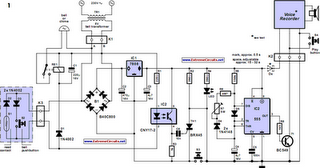Home » Circuits
You Have Mail!
If your letterbox is some distance from your house, you will find a monitoring device useful to indicate when new post has arrived. This can take the form of a US-style visible flag; a more modern alternative uses a 433 MHz radio transceiver. The big advantage of the solution presented here is that is can use an existing two-core bell cable, without requiring any further power source. The arrival of post is signalled by a blinking LED; for added effect, a digital voice recorder can also be connected which will, at regular intervals, announce the fact that the letterbox needs emptying. The device is silenced by a reset button.The circuit uses one half-cycle of the AC supply to power the bell or buzzer, and the other half-cycle for the post indicator. Suitably-oriented diodes in the device and in the letterbox ensure that the two signals are independent of one another (Figure 1). The bell current flows from K1.A through D3, bell-push S2, D1 and the relay back to K1.B. C1 provides adequate smoothing of the current pulses to ensure that the relay armature does not vibrate. The bell is operated by the normally-open relay contact. If the bell is actually a low-current piezo buzzer, then it can be connected directly and the relay dispensed with.
During the half-cycle for the letterbox monitor current flows from connection K1.B on the bell transformer through current-limiting resistor R1, the LED in the optocoupler, reed contact S1 (a microswitch can also be used) and D2 and finally back to K1. If the reed contacts are closed, the LED in the optocoupler will light and switch on the phototransistor. A positive voltage will then appear across R3 which will turn the thyristor on via C6. The red LED will indicate that post has arrived. Pressing S3 shorts out the thyristor, reducing the current through it below the holding value. A small extra circuit can be added to provide continuous letterbox monitoring.
Circuit diagram:

This takes the form of a voice recorder whose ‘play’ button is operated by transistor T1. T1 in turn is driven by a 555 timer IC. In the usual 555 timer circuit, where the device is configured as an astable multi-vibrator, the mark-space ratio cannot be set with complete freedom. Here two diodes provide separate charge and discharge paths for capacitor C4. When capacitor C4 is charging, D5 conducts and D4 blocks: the charge rate is determined by R5. When discharging, D4 conducts and R6 and the potentiometer determine the rate. The values shown give a pulse length of approximately 0.5 s with a delay of between 15 s and 32 s.
The short pulse is sufficient to trigger the voice recorder module via transistor T1 connected across its ‘play’ button. The voice recorder module (e.g. Conrad order code 115266) is designed to run from a 6 V supply. The maximum recording time is 20 s and the current consumption is 20 mA when recording and between 40 mA and 60 mA when playing back. Since our supply is at 8 V, the excess voltage must be dropped using between 1 and 3 series-connected 1N4148 diodes (shown as Dx in the circuit diagram). The final voltage should be checked using a multimeter. Alternatively, a 7806 can be used without suffering a significant loss in volume.
If it is desired to use a piezo buzzer to provide an acoustic signal, the pulse length should be increased to at least 2s. In this case, R5 should be increased to 560 kΩ or 680 kΩ: the pulse length, t on, is 0.7.R5.C4, and the interval between pulses, t off, is 0.7. (R6+R7).C4. Suitable buzzers are available with a wide range of rated voltages.
Author: Robert Edlinger - Copyright: 2004 Elektor Electronics
